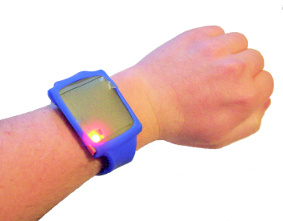Using Personal Informatics to Motivate Physical Activity: Could We Be Doing It Wrong?
Ian Li
March 13, 2012
 This is a guest post by Patrick Burns, who is a PhD candidate in the School of Computing and Information Systems at the University of Tasmania in Hobart, Australia. He is researching the use of technology to promote physical activity. His interests include ubiquitous and wearable computing and ambient displays.
This is a guest post by Patrick Burns, who is a PhD candidate in the School of Computing and Information Systems at the University of Tasmania in Hobart, Australia. He is researching the use of technology to promote physical activity. His interests include ubiquitous and wearable computing and ambient displays.
According to the World Health Organization more than one in ten adults worldwide in 2008 was obese. This figure has more than doubled since 1980. We know that obesity is a major risk factor for heart disease, diabetes, osteoarthritis and some forms of cancer. Unsurprisingly a combination of inadequate exercise and increased consumption of fatty, sugary foods is to blame. When it comes to a lack of physical activity, some people point the finger at technology. Cars let us drive to places we used to walk. Machines do jobs we used to do by hand. Video games, DVDs, television and the Internet provide a wealth of sedentary entertainment options. But could technology actually help us to do more physical activity, and ideally help prevent obesity?
One approach is to help people to better track their activity. The hope being that if we make a person more aware of their physical activity (or lack of it) that they will be motivated to do more. There are a number of existing devices designed to do just that. Examples are FitBit, Jawbone UP and Nike FuelBand. Each integrates a motion sensor (accelerometer) into a wearable device to track how much the wearer moves around during the day. There are also stand-alone smartphone apps which use the phone’s in-built accelerometer to track physical activity. In the case of the UP and some smartphone apps, the user can supplement their activity data with information on the type of food they’re eating. The UP and FitBit also monitor users’ sleep habits.
The data collected are processed and delivered to the user in the form numbers and graphs. A count of steps taken each day. Time active vs. sedentary. Steps climbed. Calories burned. There is an assumption that, when it comes to activity tracking, more is better. That we should collect more data from more sensors. That we should perform more analyses on that data and present it to the user in multiple forms. We should make our interfaces more engaging, to encourage users to continue to monitor their activity data. In the words of Jawbone’s VP of product development, “you have to create a Facebook-like engagement that keeps people coming back”.
The truth or otherwise of these assumptions is very much dependent on individual users, and the way in which they employ a particular technology in their lives. Users who are very motivated to do exercise, sometimes playfully called “fitness freaks” or “gym junkies”, employ activity monitoring technology in a supporting role. They already do a lot of physical activity and enjoy being able to record, quantify and analyse that activity. But what about less motivated users – people who don’t do enough physical activity and know that they should do more? For those users technology plays a motivating role, one in which the technology is (and should be) more peripheral to their day-to-day lives.
If we give these users an interface that is too complex, or that requires a continuing and significant time commitment, we run the risk that they will lose interest, “burn out” and return to old habits. Many of us have had the experience of starting a diet, joining a gym or buying exercise equipment only to give up soon after. These experiences underline the need to make small changes, slowly, that can be sustained in the long term. We need to design technology to support this type of change.
I argue that for these less motivated users, simpler interfaces could be just as effective as more complex, more engaging interfaces. Do we really need to know exactly how many steps we’ve taken or how many calories we’ve burned? Or is it good enough just to know that we’ve “done well” today or that we need to “do more”. Do we really need graphs and figures, or could we convey information in a simpler way. Say, through coloured lights.
I’m currently researching the use of simple interfaces to deliver physical activity information to users, with a specific focus on wearable technology. I recently designed and evaluated such a device – ActivMON. ActivMON is a wrist-watch like device containing a motion sensor and coloured light. The motion sensor detects the user’s physical activity and the light changes colour (on a spectrum from red to orange to green) to show the user’s daily activity level as compared to an activity goal. ActivMON then shares this data through the Internet with other devices. If you’re doing physical activity then the lights on your friends’ devices will pulse to let them know. If they’re doing physical activity, your device will pulse. Supporting social influence is important, and I wanted to see if this could be done using a wearable ambient display.
This work is still in its early stages, but I feel it raises some interesting questions. Should we deliver information differently (and more or less information) depending on a user’s level of motivation to change? How engaging should interfaces be? How little information can we deliver, and yet still realise a motivational effect? This is not to argue against the quantified self. Rather to pose the question of how best to present data to users once we’ve collected it.




